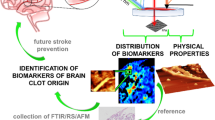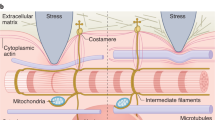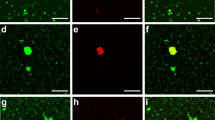Abstract
The availability of biomarkers to evaluate the risk of cardiovascular diseases is limited1. High fibrinogen levels have been identified as a relevant cardiovascular risk factor, but the biological mechanisms remain unclear2,3. Increased aggregation of erythrocytes (red blood cells) has been linked to high plasma fibrinogen concentration2,4. Here, we show, using atomic force microscopy, that the interaction between fibrinogen and erythrocytes is modified in chronic heart failure patients. Ischaemic patients showed increased fibrinogen–erythrocyte binding forces compared with non-ischaemic patients. Cell stiffness in both patient groups was also altered. A 12-month follow-up shows that patients with higher fibrinogen–erythrocyte binding forces initially were subsequently hospitalized more frequently. Our results show that atomic force microscopy can be a promising tool to identify patients with increased risk for cardiovascular diseases.
This is a preview of subscription content, access via your institution
Access options
Subscribe to this journal
Receive 12 print issues and online access
$259.00 per year
only $21.58 per issue
Buy this article
- Purchase on Springer Link
- Instant access to full article PDF
Prices may be subject to local taxes which are calculated during checkout





Similar content being viewed by others
References
Alexander, K. S., Kazmierczak, S. C., Snyder, C. K., Oberdorf, J. A. & Farrell, D. H. Prognostic utility of biochemical markers of cardiovascular risk: impact of biological variability. Clin. Chem. Lab. Med. 51, 1875–1882 (2013).
Lominadze, D., Dean, W. L., Tyagi, S. C. & Roberts, A. M. Mechanisms of fibrinogen-induced microvascular dysfunction during cardiovascular disease. Acta Physiol. (Oxf.) 198, 1–13 (2010).
Reinhart, W. H. Fibrinogen—marker or mediator of vascular disease? Vasc. Med. 8, 211–216 (2003).
Cecchi, E., Mannini, L. & Abbate, R. Role of hyperviscosity in cardiovascular and microvascular diseases. G. Ital. Nefrol. 26, 20–29 (2009).
WHO. Global Status Report on Non-Communicable Diseases 2010 (World Health Organization, 2011).
Lillioja, S. et al. Skeletal muscle capillary density and fiber type are possible determinants of in vivo insulin resistance in man. J. Clin. Invest. 80, 415–424 (1987).
Mann, D. L. & Bristow, M. R. Mechanisms and models in heart failure: the biomechanical model and beyond. Circulation 111, 2837–2849 (2005).
Follath, F. Ischemic versus non-ischemic heart failure: should the etiology be determined? Heart Fail. Monit. 1, 122–125 (2001).
Bishop, J. J., Nance, P. R., Popel, A. S., Intaglietta, M. & Johnson, P. C. Effect of erythrocyte aggregation on velocity profiles in venules. Am. J. Physiol. Heart. Circ. Physiol. 280, H222–H236 (2001).
Kim, S., Popel, A. S., Intaglietta, M. & Johnson, P. C. Aggregate formation of erythrocytes in postcapillary venules. Am. J. Physiol. Heart Circ. Physiol. 288, H584–H590 (2005).
Delamaire, M. & Durand, F. Erythrocyte aggregation and vascular pathology. J. Mal. Vasc. 15, 344–346 (1990).
Falcó, C. et al. Influence of fibrinogen levels on erythrocyte aggregation determined with the Myrenne aggregometer and the Sefam erythro-aggregometer. Clin. Hemorheol. Microcirc. 33, 145–151 (2005).
Maeda, N., Seike, M., Kume, S., Takaku, T. & Shiga, T. Fibrinogen-induced erythrocyte aggregation: erythrocyte-binding site in the fibrinogen molecule. Biochim. Biophys. Acta 904, 81–91 (1987).
Lominadze, D. & Dean, W. L. Involvement of fibrinogen specific binding in erythrocyte aggregation. FEBS Lett. 517, 41–44 (2002).
Carvalho, F. A. et al. Atomic force microscopy-based molecular recognition of a fibrinogen receptor on human erythrocytes. ACS Nano 4, 4609–4620 (2010).
Carvalho, F. A., de Oliveira, S., Freitas, T., Gonçalves, S. & Santos, N. C. Variations on fibrinogen-erythrocyte interactions during cell aging. PLoS ONE 6, e18167 (2011).
Carvalho, F. A. & Santos, N. C. Atomic force microscopy-based force spectroscopy—biological and biomedical applications. IUBMB Life 64, 465–472 (2012).
Choi, S., Jung, G. B., Kim, K. S., Lee, G. J. & Park, H. K. Medical applications of atomic force microscopy and Raman spectroscopy. J. Nanosci. Nanotechnol. 14, 71–97 (2014).
Pillet, F., Chopinet, L., Formosa, C. & Dague, E. Atomic force microscopy and pharmacology: from microbiology to cancerology. Biochim. Biophys. Acta 1840, 1028–1050 (2014).
Thiagarajan, P., Rippon, A. J. & Farrell, D. H. Alternative adhesion sites in human fibrinogen for vascular endothelial cells. Biochemistry 35, 4169–4175 (1996).
Carvalho, F. A. et al. Dengue virus capsid protein binding to hepatic lipid droplets (LD) is potassium ion dependent and is mediated by LD surface proteins. J. Virol. 86, 2096–2108 (2012).
Baskurt, O. K. & Meiselman, H. J. Blood rheology and hemodynamics. Semin. Thromb. Hemost. 29, 435–450 (2003).
Ebner, A., Schillers, H. & Hinterdorfer, P. in Atomic Force Microscopy in Biomedical Research Vol. 736 (eds Braga, P. C. & Ricci, D.) 223–241 (Humana, 2011).
Maciaszek, J. L. & Lykotrafitis, G. Sickle cell trait human erythrocytes are significantly stiffer than normal. J. Biomech. 44, 657–661 (2011).
Rand, P. W., Lacombe, E., Hunt, H. E. & Austin, W. H. Viscosity of normal human blood under normothermic and hypothermic conditions. J. Appl. Phys. 19, 117–122 (1964).
Papaioannou, T. G. & Stefanadis, C. Vascular wall shear stress: basic principles and methods. Hellenic J. Cardiol. 46, 9–15 (2005).
Schmid-Schonbein, H., Wells, R. E. & Goldstone, J. Fluid drop-like behaviour of erythrocytes—disturbance in pathology and its quantification. Biorheology 7, 227–234 (1971).
McMurray, J. J. et al. ESC guidelines for the diagnosis and treatment of acute and chronic heart failure 2012: The Task Force for the Diagnosis and Treatment of Acute and Chronic Heart Failure 2012 of the European Society of Cardiology. Developed in collaboration with the Heart Failure Association (HFA) of the ESC. Eur. Heart J. 33, 1787–1847 (2012).
Hutter, J. L. & Bechhoefer, J. Calibration of atomic-force microscope tips. Rev. Sci. Instrum. 64, 1868–1873 (1993).
Chen, A. & Moy, V. T. Cross-linking of cell surface receptors enhances cooperativity of molecular adhesion. Biophys. J. 78, 2814–2820 (2000).
Kienberger, F., Kada, G., Mueller, H. & Hinterdorfer, P. Single molecule studies of antibody–antigen interaction strength versus intra-molecular antigen stability. J. Mol. Biol. 347, 597–606 (2005).
Neundlinger, I. et al. Forces and dynamics of glucose and inhibitor binding to sodium glucose co-transporter SGLT1 studied by single molecule force spectroscopy. J. Biol. Chem. 289, 21673–21683 (2014).
Zhang, X., Wojcikiewicz, E. & Moy, V. T. Force spectroscopy of the leukocyte function-associated antigen-1/intercellular adhesion molecule-1 interaction. Biophys. J. 83, 2270–2279 (2002).
Acknowledgements
This work was supported by Fundação para a Ciência e a Tecnologia – Ministério da Ciência, Tecnologia e Ensino Superior (FCT-MCTES, Portugal) grants PTDC/QUI-BIQ/119509/2010 and PTDC/BBB-BMD/6307/2014, as well as fellowship SFRH/BD/84414/2012 to A.F.G. The authors thank T. Freitas (FMUL) for technical assistance.
Author information
Authors and Affiliations
Contributions
A.F.G. performed AFM experiments, analysed force spectroscopy data, performed the statistical analysis, wrote and edited the draft and prepared the manuscript for submission. F.A.C. analysed the force spectroscopy data, wrote the manuscript and edited successive drafts of the paper. I.M. performed some of the initial AFM experiments and analysed their data. L.S. collected all clinical data, performed some statistical analysis, contributed to relevant discussions and edited the draft. N.L. contributed to the discussion section and N.C.S. conceived the idea, designed and directed the AFM experiments, analysed the data, wrote the manuscript and edited successive drafts of the paper.
Corresponding authors
Ethics declarations
Competing interests
The authors declare no competing financial interests.
Supplementary information
Supplementary information
Supplementary information (PDF 795 kb)
Rights and permissions
About this article
Cite this article
Guedes, A., Carvalho, F., Malho, I. et al. Atomic force microscopy as a tool to evaluate the risk of cardiovascular diseases in patients. Nature Nanotech 11, 687–692 (2016). https://doi.org/10.1038/nnano.2016.52
Received:
Accepted:
Published:
Issue Date:
DOI: https://doi.org/10.1038/nnano.2016.52



